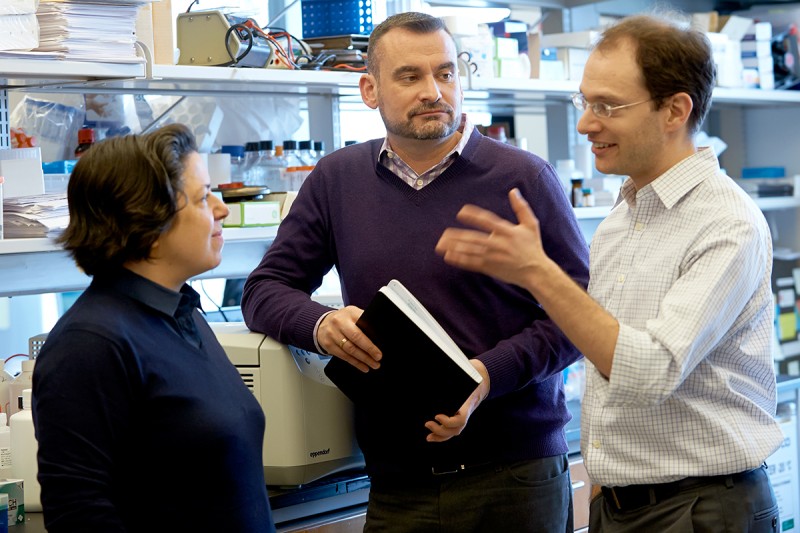
Jason Lewis (center) with Anna-Katerina Hadjantonakis and Daniel Heller
Memorial Sloan Kettering has launched a collaborative center that will unite researchers specializing in two rapidly growing fields—molecular imaging and nanotechnology. The center will speed research into the biology of cancers and augment the development of new clinical applications.
“One of the most powerful ways to learn about cancer is to visualize it,” says radiochemist Jason Lewis, who recently was appointed the inaugural Director of the Center for Molecular Imaging and Nanotechnology (CMINT). “Molecular imaging is a very powerful way to interrogate pure biology, both at the cellular level and in humans.”
Molecular imaging makes it possible to observe and measure biological processes in living cells or tissues over time — without disrupting them — by lighting them up with specific imaging agents. Memorial Sloan Kettering investigators have pioneered the development of molecular imaging methods since the 1990s — including fluorescence imaging, PET, and MRI — to aid laboratory investigations into the root causes of cancer as well as to improve many aspects of cancer care, from the initial detection of the disease to diagnostics, surgery, and drug therapy.
For example, Dr. Lewis explains, “we can use molecular imaging to track the distribution of a drug or measure its activity in a patient’s body. In some cases, this allows us to ask whether a person will benefit from a certain drug.” Molecular imaging also helps clinicians learn as much as possible about a new therapy when testing it in a clinical trial.
Collaboration and Cross-Fertilization
The CMINT brings together imaging experts working in many different fields. Some, like Dr. Lewis, are focused on developing radiopharmaceuticals for medical cancer imaging. Others, like chemist and engineer Daniel Heller, specialize in nanotechnology, which offers new tools for cancer biology research, diagnostics, and therapies. Still others study the most fundamental aspects of life and disease, including developmental biologist Anna-Katerina Hadjantonakis, whose lab uses cell-imaging technologies to gain insight into biological processes that drive the formation of mammalian embryos and the stem cells that can be obtained from them.
The center’s faculty also includes experts in medicine, genomics, pharmacology, and other disciplines.
“One of our goals is to start conversations between scientists who image cells under the microscope and those who look at cancer in patients,” Dr. Lewis notes. “Traditionally the two areas haven’t had much overlap, but the way of the future is to bridge them.”
Hedvig Hricak, who chairs the Department of Radiology, elaborates: “Every time you create an infrastructure that fosters collaboration and cross-fertilization of ideas, everyone learns faster, so research accelerates. By tying together multiple basic and clinical science disciplines, we maximize our chances of finding effective solutions to clinical problems and translating them into medical applications that ultimately will help patients.”
A New Scene for Nanotechnology
The CMINT melting pot will incorporate a number of scientists who were part of the former Center for Nanotechnology, including Dr. Heller. “Nanomaterials have very unique and exciting properties that offer new, ‘smart’ therapies consisting of tiny particles to target drugs to cancer sites, as well as sensors for improved cancer detection,” Dr. Heller says.
One of the projects in his lab is to develop medical sensors based on carbon nanotubes to detect cancer at its earliest stages. These particles measure about one nanometer in diameter — about 100,000 times smaller than the width of a human hair — and can give off light that penetrates skin.
While molecular imaging and nanotechnology are traditionally considered separate disciplines, they are inherently linked at MSK. “Nanotechnology will allow the development of many new molecular imaging tracers,” notes Dr. Hricak. “And molecular imaging can itself play an important role in the development and translation of new nanotechnology innovations.”
In collaboration with Hunter College, the CMINT will also support a graduate training program in molecular imaging and nanotechnology. “There is a lack of PhD scientists who are well-trained in these disciplines, and it’s really becoming an issue,” Dr. Lewis says. “Yet the goal of the program is not necessarily to have all our students become ‘molecular imagers’ but rather to help them learn and appreciate what imaging can do to augment whatever research area they choose to pursue. I see it as a way to train the very best biomedical scientists.”





